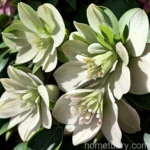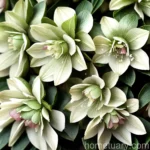Hellebore (Helleborus x hybridus ‘Pine Knot Best Darks’)
Hellebores, also known as the Lenten Rose, are gorgeous perennial plants that have gained popularity for their ability to bloom in the winter, making them a valuable addition to any garden. Among the many varieties of hellebores, the ‘Pine Knot Best Darks’ cultivar, a hybrid of Helleborus x hybridus, stands out for its stunning dark-colored blooms. In this comprehensive guide, we will delve into the culture, uses, care tips, and more for the ‘Pine Knot Best Darks’ hellebore. Let’s explore the enchanting world of hellebores and uncover the secrets of cultivating and caring for these fascinating plants.
What is Hellebore (Helleborus x hybridus ‘Pine Knot Best Darks’)?
Helleborus x hybridus ‘Pine Knot Best Darks’ is a variety of hellebore that belongs to the Ranunculaceae family. These evergreen perennials are renowned for their exquisite, long-lasting blooms, and their ability to thrive in shaded areas, especially under deciduous trees. The captivating dark-colored flowers of the ‘Pine Knot Best Darks’ hellebore add a touch of elegance and intrigue to any garden, making it a sought-after choice for landscape designers and gardening enthusiasts.
Key Takeaways – Hellebore (Helleborus x hybridus ‘Pine Knot Best Darks’)
Before delving into the specifics of the culture, uses, and care tips for the ‘Pine Knot Best Darks’ hellebore, let’s highlight the key takeaways that make this plant a unique and desirable addition to gardens:
- Hellebores, particularly the ‘Pine Knot Best Darks’ cultivar, are winter blooming plants that bring late winter garden interest with their charming blooms.
- This variety is known for its dark-colored and long-lasting flowers, adding a touch of elegance and allure to garden landscapes.
- Hellebores are shade-tolerant plants, making them ideal for growing under deciduous trees and in other shaded areas.
- ‘Pine Knot Best Darks’ hellebore is an evergreen perennial, providing year-round foliage interest and a reliable presence in the garden.
- When properly cared for, hellebores, including the ‘Pine Knot Best Darks’ cultivar, are low-maintenance plants, requiring minimal attention and care to thrive.
Culture
Understanding the specific cultural requirements of hellebores, particularly the ‘Pine Knot Best Darks’ cultivar, is essential for successfully cultivating these enchanting plants. From planting to maintenance, here are the key cultural aspects to consider when growing ‘Pine Knot Best Darks’ hellebores:
Planting Helleborus x hybridus ‘Pine Knot Best Darks’
- Soil: Hellebores prefer well-draining soil rich in organic matter. A slightly acidic to neutral pH range of 5.5 to 7.0 is optimal for their growth.
- Location: Choose a shaded or partially shaded area for planting ‘Pine Knot Best Darks’ hellebores. These plants thrive under deciduous trees or in locations with filtered sunlight.
- Planting Depth: When transplanting hellebores, ensure the crown of the plant is at ground level. Planting too deeply can impede their growth and blooming.
Uses
Hellebores, including the ‘Pine Knot Best Darks’ variety, have several uses in garden landscapes and outdoor spaces. Here are some common applications for these delightful plants:
- Garden Beds: ‘Pine Knot Best Darks’ hellebores make exceptional additions to perennial beds and shaded garden areas, providing long-lasting blooms and evergreen foliage interest.
- Containers: Due to their adaptability, hellebores can be grown in containers, allowing for versatile and creative placement within garden designs.
- Cut Flowers: The dark-colored blooms of ‘Pine Knot Best Darks’ hellebores can be cut and used in floral arrangements, adding a unique touch to indoor décor.
Water
Proper watering is essential for the health and vitality of ‘Pine Knot Best Darks’ hellebores. Consider the following recommendations when watering these stunning plants:
- Watering Frequency: Hellebores generally prefer consistently moist soil, especially during periods of active growth and flowering.
- Avoid Overhead Watering: To prevent disease and rot, it is best to water hellebores at the base rather than using overhead irrigation methods.
Sunlight
As shade-tolerant plants, ‘Pine Knot Best Darks’ hellebores thrive in locations with filtered sunlight or partial shade. When considering their placement in the garden, keep the following sunlight requirements in mind:
- Partial Shade: Hellebores, including the ‘Pine Knot Best Darks’ cultivar, perform best in locations with dappled sunlight or partial shade, particularly under deciduous trees or in areas with filtered light.
- Optimal Light Conditions: While hellebores can tolerate some morning sun, they generally prefer protection from intense midday and afternoon sunlight.
Fertilizer
Proper fertilization can contribute to the overall health and vigor of ‘Pine Knot Best Darks’ hellebores. Consider the following guidelines for fertilizing these plants:
- Timing: Apply a balanced, slow-release fertilizer in early spring as new growth emerges, providing the necessary nutrients for healthy blooming and foliage development.
- Application Method: When applying fertilizer, ensure it is distributed evenly around the plants, and water thoroughly to help the nutrients reach the root zone.
Soil
The soil composition and quality play a crucial role in the growth and performance of ‘Pine Knot Best Darks’ hellebores. Here are some key considerations for soil management:
- Well-Draining Soil: Hellebores thrive in well-draining soil that prevents waterlogging and promotes healthy root development.
- Organic Matter: Amending the soil with organic matter, such as compost or well-rotted manure, can improve its structure and provide essential nutrients for hellebores.
- pH Level: Aim for a slightly acidic to neutral pH range of 5.5 to 7.0, as hellebores prefer soil with these characteristics for optimal growth and blooming.
Pruning
Pruning hellebores, including the ‘Pine Knot Best Darks’ cultivar, is a simple yet important task that can promote tidiness and vigor in these plants. Follow these guidelines for successful pruning:
- Remove Old Foliage: In late winter or early spring, remove any old or damaged foliage from the previous growing season to allow for the emergence of new growth and flowers.
- Deadheading Blooms: After the flowering period, deadhead spent blooms to encourage ongoing flowering and prevent the formation of seeds.
Propagation
Expanding your collection of ‘Pine Knot Best Darks’ hellebores or sharing these enchanting plants with fellow gardening enthusiasts can be achieved through various propagation methods. Consider the following approaches for propagating hellebores:
- Division: Divide mature hellebore clumps in early spring, ensuring that each division has sufficient roots and growing points to establish new plants.
- Seeds: Collect and sow hellebore seeds in suitable growing conditions, providing the necessary warmth and moisture for successful germination and seedling development.
- Root Cuttings: Propagate hellebores from root cuttings, taking sections of the roots and establishing them in a suitable rooting medium to encourage new plant growth.
Container Popularity
Hellebores, including the ‘Pine Knot Best Darks’ variety, have gained popularity as container plants due to their adaptability and aesthetic appeal. When growing hellebores in containers, keep the following considerations in mind:
- Container Size: Choose spacious containers that allow for adequate root development and growth of the ‘Pine Knot Best Darks’ hellebores.
- Well-Draining Soil: Use well-draining potting mix to ensure proper moisture management and prevent waterlogging in containers.
- Placement: Position the containers in shaded or partially shaded areas to provide the optimal growing conditions for hellebores.
Common Diseases
Although hellebores, including the ‘Pine Knot Best Darks’ cultivar, are relatively low-maintenance plants, they can be susceptible to certain diseases. Familiarize yourself with the common diseases that may affect these captivating plants:
- Black Death: This fungal disease can cause blackening and deformation of the foliage, leading to the decline of affected plants. Proper sanitation and management practices can help prevent the spread of black death in hellebores.
- Leaf Spot: Leaf spot diseases can manifest as circular lesions on the foliage, affecting the overall appearance and health of hellebores. Implementing proper watering and sanitation practices can mitigate the risk of leaf spot infections.
Disease Diagnosis
Diagnosing and addressing diseases in ‘Pine Knot Best Darks’ hellebores requires keen observation and prompt action. Consider the following steps for effectively diagnosing and managing diseases in these plants:
- Symptom Recognition: Familiarize yourself with the common symptoms of hellebore diseases, including leaf discoloration, leaf spot formations, and abnormal growth patterns.
- Consultation: Seek the advice of horticultural professionals or plant specialists for accurate disease diagnosis and targeted management strategies.
- Preventive Measures: Implement proactive measures, such as proper sanitation, to minimize the risk of diseases in ‘Pine Knot Best Darks’ hellebores and other garden plants.
Common Pests
While hellebores are generally resistant to pests, occasional pest infestations may occur. Understanding the common pests that could impact ‘Pine Knot Best Darks’ hellebores is essential for effective pest management:
- Aphids: These small, sap-sucking insects can cluster on the foliage and stems of hellebores, leading to stunted growth and reduced plant vigor. Natural predators and targeted insecticidal treatments can help control aphid populations.
- Spider Mites: Spider mites can cause stippling and webbing on the foliage of hellebores, impacting their overall appearance and health. Regular monitoring and the use of miticides can help manage spider mite infestations.
Botanist’s Tips
As a plant scientist and enthusiast, I offer the following tips for successfully growing and caring for ‘Pine Knot Best Darks’ hellebores:
- Seasonal Mulching: Apply a layer of organic mulch around hellebores, particularly in late fall, to insulate the soil and protect the plants’ roots during winter.
- Regular Monitoring: Routinely inspect ‘Pine Knot Best Darks’ hellebores for signs of disease, pest infestations, and any cultural issues, allowing for timely intervention and management.
- Selective Pruning: When pruning hellebores, exercise caution to avoid damaging emerging flower buds, and selectively remove old foliage to promote healthy new growth.
Fun Facts
Uncover some fascinating and lesser-known facts about ‘Pine Knot Best Darks’ hellebores:
- Historical Significance: Hellebores have a rich history and have been cultivated for centuries for their medicinal and ornamental properties, contributing to their enduring allure.
- Foliage Diversity: In addition to their captivating blooms, hellebores exhibit a wide range of foliage variations, including intricate patterns and vibrant hues.
- Symbolic Meanings: Hellebores are often associated with themes of hope, new beginnings, and rebirth, adding a symbolic layer of significance to their presence in gardens.
Links to External Resources
For further exploration of hellebores, their culture, and care, consider the following resources:
- The Royal Horticultural Society – Hellebores
- American Society for the Prevention of Cruelty to Animals – Hellebore Poisoning in Dogs and Cats
In conclusion, the ‘Pine Knot Best Darks’ hellebore, with its captivating dark-colored blooms and adaptability to shaded environments, presents a compelling option for gardeners seeking winter-blooming, shade-tolerant plants with evergreen foliage. By understanding the cultural requirements, uses, and care tips for ‘Pine Knot Best Darks’ hellebores, you can embark on a rewarding journey of cultivating and enjoying these enchanting plants in your garden or outdoor spaces.
Remember to embrace the unique charm and resilience of hellebores, and may their elegant blooms bring joy and beauty to your garden year after year.
Happy gardening!















